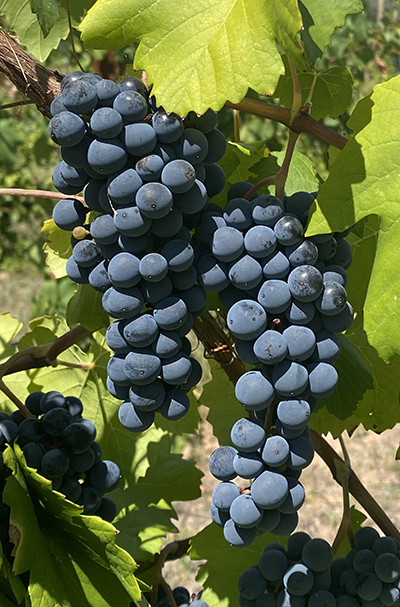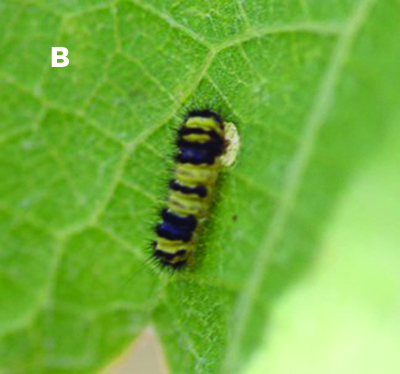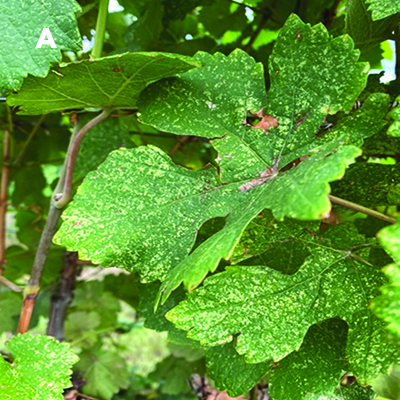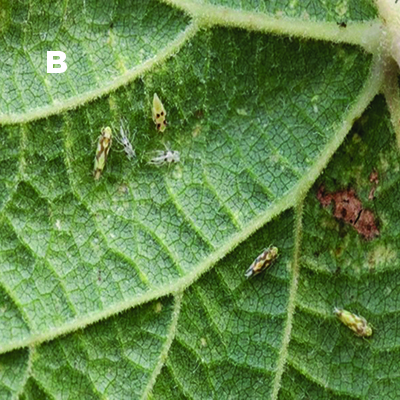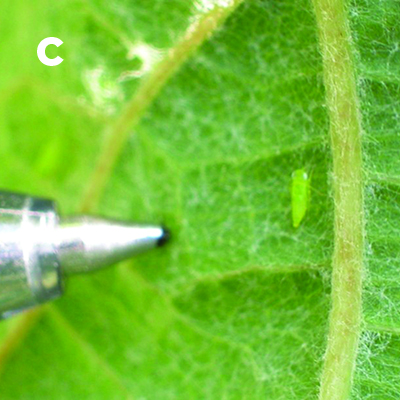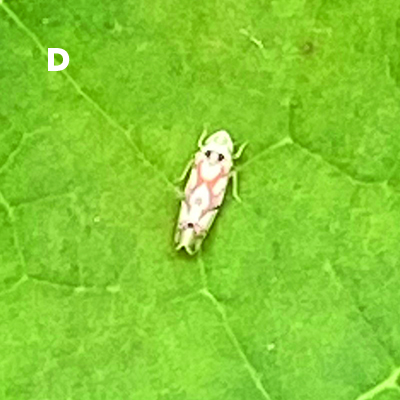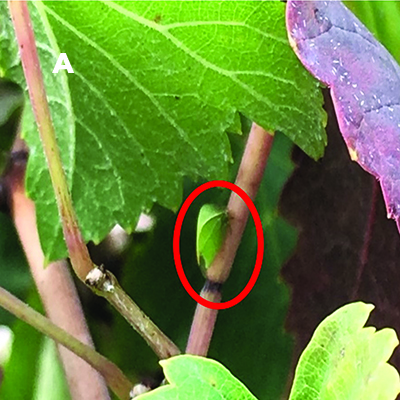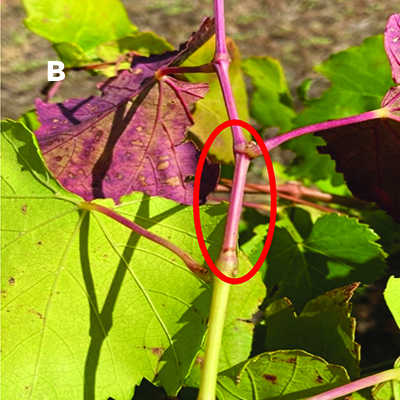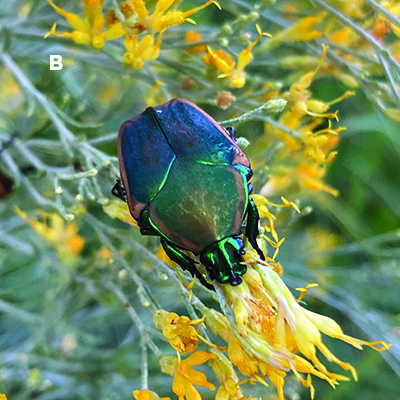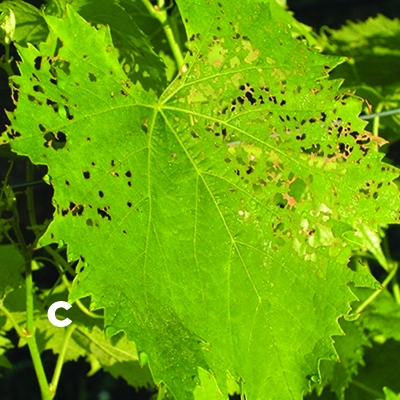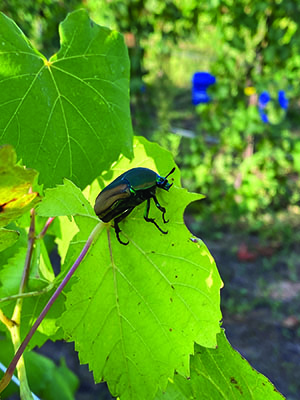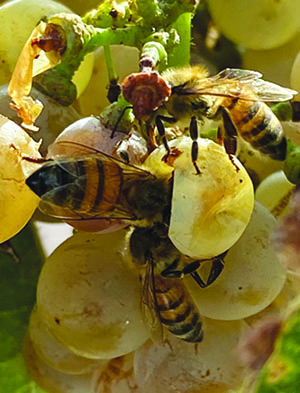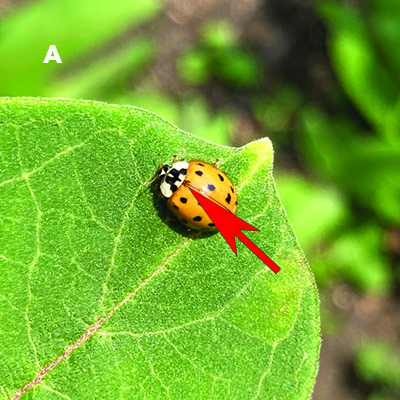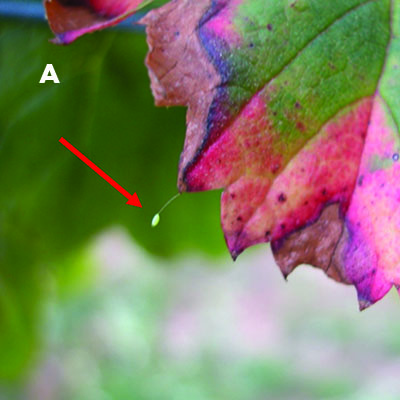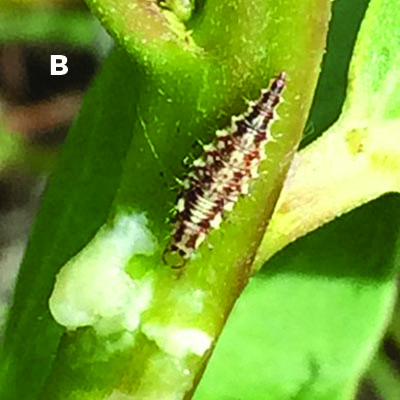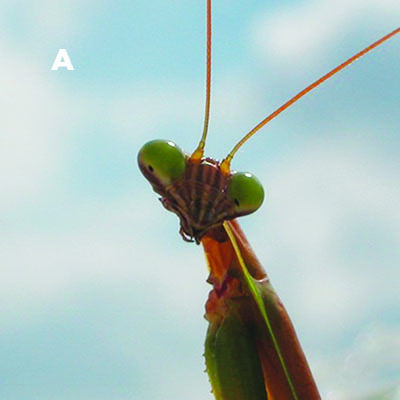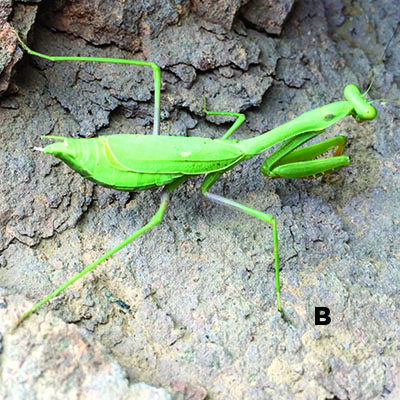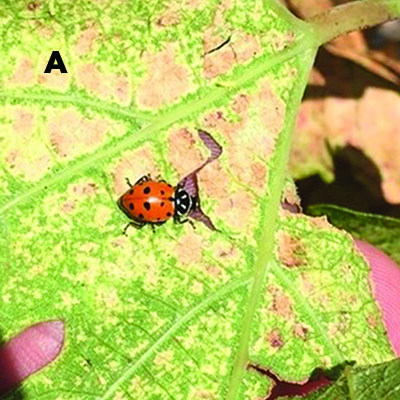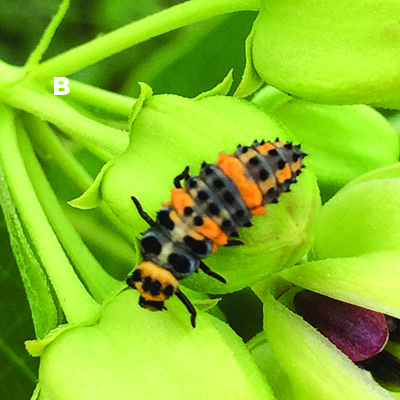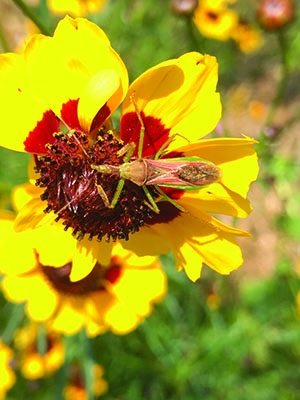Circular 705
Miranda L. Kersten and Gill Giese
College of Agricultural, Consumer and Environmental Sciences, New Mexico State University
Authors: Respectively, IPM Program Manager, Agricultural Science Center at Los Lunas; and Extension Viticulture Specialist, Department of Extension Plant Sciences/Agricultural Science Center at Los Lunas, New Mexico State University. (Print Friendly PDF)
Introduction
Integrated pest management (IPM) emphasizes preventing pests and pest damage by implementing proactive control strategies and techniques. IPM’s overall goal is managing pests to minimize chemical inputs that can harm the environment and people. Avoiding or mitigating conditions that are conducive to pests and diseases while monitoring pest populations and growing conditions are fundamental to an effective IPM program. In commercial vineyards, grapevines should be continually observed for pest presence and damage, as well as for disease signs and symptoms. Regular observation and repetitive monitoring ensure the best chance of catching a pest infestation or disease infection early in its cycle. The most effective time to apply chemical pesticides is often early in the infestation or infection cycle. Making a timely and effective application within this small “window” of opportunity helps ensure that the most effective rate of chemical pesticide is applied, and any negative impacts on natural enemies and the environment are minimized. Overall, pesticides are applied only when necessary. An IPM program consists of four key steps: prevention, identification, monitoring, and management.
Prevention: Avoid insect pests and diseases by selecting tolerant/resistant cultivars and rootstocks. The vineyard site itself also plays a role. A site prone to cold or frost injury can result in injured vines that are more susceptible to disease such as crown gall (Agrobacterium vitis). Cultivars and rootstocks should be best adapted to the site’s soil and climate. Advantageous site selection, good soil health, proper trellising and training, regular watering, and nutrient management (monitored with regular petiole testing) promote healthy, thriving vines that are best able to prevent and mitigate disease infection and insect infestation and damage.
Identification: Regular monitoring, observation, and verification leads to accurate and timely identification of pests and disease signs and symptoms, and is critical to creating an effective IPM plan and course of action.
Monitoring: Regularly inspect grapevines, including leaves, stems, and berries, for signs of infection, damage, or pests. Monitoring after management (e.g., chemical or mechanical) will help you manage successes and shortcomings and implement changes, adjustments, and possible improvements to the IPM plan.
Management: Use a combination of IPM strategies to manage pest problems. IPM strategies include cultural, mechanical, biological, and chemical management practices. Below is a description of each strategy.
Cultural control strategies can make the environment less suitable for pests. Examples include:
- Selecting and planting tolerant/resistant cultivars, including hybrids.
- Advantageous vineyard site selection to protect from winter cold, untimely frosts, and unsuitable soils. Vines injured by cold or those struggling with less-than-ideal soil conditions are vulnerable to insect attack and disease infection.
- Canopy management, including appropriate dormant and growing season pruning, training, trellising, and leaf and lateral removal.
- Regular watering, including monthly water application during the winter dormant season if no precipitation occurs, and sufficient nutrient management according to biennial petiole testing.
- Crop load management by matching the cluster number and distribution to the vine’s vegetative growth. A rule of thumb for judging vine carrying capacity is for shoots over 36 inches long and with 12 to 17 functional leaves, allow one to two medium-sized clusters; for shoots 18 to 24 inches, leave one cluster; and for shoots less than 18 inches, leave no fruit.
- Planting cover crops to mitigate erosion, contribute mineral nutrients, support a healthy soil microbiome, and improve the soil’s physical properties of water-holding capacity, infiltration rate, and bulk density.
Mechanical or physical control strategies include barriers that protect plants by excluding pests. Examples include:
- Removing pests by hand.
- Trapping to monitor for pests and reduce low-level pest populations.
- Removing weeds and surrounding vegetation that may harbor insect pests.
Biological controls use living organisms, often natural enemies, to suppress pest populations. To promote natural enemies that are already present (conservation biological control), use the following techniques:
- Plant cover crops that promote beneficial insects by providing floral resources.
- Learn to distinguish the beneficial insects from the pests.
- Avoid or limit use of insecticides to protect natural pest suppression provided by natural enemies.
Chemical controls involve applying synthetic or naturally derived compounds to kill or repel pests or interrupt their growth. In an IPM program, chemical controls should be used when other methods have not worked, and pests have reached a treatment threshold.
- The timing of chemical pesticide application is critical, and they should be applied when pests are most vulnerable and at the labelled rate.
- If possible, apply chemical controls on a limited basis, i.e., “spot-spraying” areas determined to be especially prone to infestations or infection. This targeted application of chemicals reduces costs and protects natural enemies.
This guide introduces IPM and provides background on grape cultural practices appropriate and in some cases unique to New Mexico, as well as specific information on some of the common insect pests of grapes in the state, identification tips, and key IPM management strategies for these selected grape pests. Bolded terms are defined in the glossary.
Insects Affecting Leaves And Shoots
Western grapeleaf skeletonizer (Harrisina brillians, Figures 1A–1C)
Figures 1A–1C. Western grapeleaf skeletonizer caterpillars feeding on the underside of a grape leaf (A) and single caterpillar (B). Adults may be seen flying in the daytime (C; photo by David Cappaert, Bugwood.org).
Biology and Life Cycle:
- Adults emerge in spring during leaf expansion.
- Eggs are laid on underside of leaves.
- Larvae undergo five instar stages. Early instars are gregarious, while late instars feed alone.
- Pupae overwinter under debris or bark in silken cocoons.
- Two to three generations per year. Damaging populations are often observed by midseason prior to veraison.
ID Tips:
- Eggs are translucent, light yellow, capsule-shaped, laid in clusters of 10–200; eggs do not touch.
- First two instars are cream-colored, the third instar is brownish, and the last two instars are yellow with purple and blackish bands, up to 5/8 inch long.
- Adults are black to metallic blue moths with a 1-inch wingspan.
WARNING: Black spines on larvae can cause skin welts if handled.
Damaging Stage: Larvae
Damage:
- Larvae feed on leaves. Young larvae feed on the underside of leaves; feeding by late instar stages skeletonizes leaves.
- High abundances can cause defoliation.
- When fruit is present, defoliation may result in sunburned and lower-quality fruit.
- After harvest, defoliation may weaken vines.
Management:
- Monitor undersides of leaves for egg masses and young larvae.
- Hand-remove and destroy eggs and larvae. Hand removal is more efficient when larvae are young and feed close together.
- Two parasitoids, including a tachinid fly and a parasitoid wasp, attack the western grapeleaf caterpillars and can reduce their populations. (See http://ipm.ucanr.edu/PMG/GARDEN/FRUIT/PESTS/neparasites.html for photos of parasitoids.)
- Conventional insecticides are available; use targeted applications to areas with active larval feeding.
- Organic insecticide options include Bt (Bacillus thuringiensis) var. kurstaki and spinosad.
Leafhopper (Erythroneura spp., Figures 2A–2D)
Figures 2A–2D. Leafhopper feeding causes white spotting on leaves (A); adult and nymph stages feeding on underside of a leaf, with white castings from a molt visible (B); immature leafhopper (nymph) with a ballpoint pen tip for scale reference (C); and adult with wing pattern visible (D).
Biology and Life Cycle:
- Females appear in the spring and insert eggs into the leaf.
- Eggs hatch after 1 to 2 weeks.
- Nymphs and adults use their piercing-sucking mouthparts to puncture leaf cells and suck out contents.
- Adults overwinter in leaf litter.
- Two to three generations per year are typical in New Mexico.
ID Tips:
- Leafhoppers have a creamy white wedge-shaped body, about 1/10 inch long, pale yellow to red markings on wings, and a triangular head with large eyes on the sides.
- Nymphs look similar to adults but lack wings.
Damaging Stage: Nymphs and adults
Damage:
- Feeding causes yellow and white blotching on leaves.
- Heavy feeding can reduce the ability of leaves to photosynthesize, resulting in defoliation and decreased fruit quality.
Management:
- Monitor for nymphs and feeding damage to leaves. On average, chemical controls should be applied when 20 nymphs per leaf are counted.
- Remove overwintering habitat to reduce spring populations.
- Remove basal leaves during the first generation of leafhoppers, which preferentially feed on basal leaves. Removing basal leaves can reduce population growth and plant damage. Be careful to not remove an overabundance of basal leaves, which can result in overexposure and sunburning of the grape clusters.
- Many generalist-type insect predators feed on grape leafhoppers, including spiders, green lacewings, lady beetles, and assassin bugs, which provides natural pest suppression.
For more detailed information on leafhopper biology and management, including treatment threshold information and chemical options, see NMSU Extension Guide H-332, Managing Grape Leafhoppers on New Mexico Grape Vines (https://pubs.nmsu.edu/_h/H332/).
Three-cornered alfalfa hopper (Spissistilus festinus, Figures 3A and 3B)
Figures 3A and 3B. An adult three-cornered alfalfa leafhopper (within the red circle) with evidence of petiole girdling due to feeding just below it (A); feeding damage in two locations (within the red circle), resulting in reddened shoots and leaves above the girdling damage (B).
Biology and Life Cycle:
- Females deposit eggs into plant stems.
- Nymphs feed on plants and undergo five nymphal stages. Latter stages do the most feeding damage.
- Adults can fly between host plants.
- Adults overwinter in clump grasses, while eggs are laid and overwinter in plant stems.
- Legumes, such as alfalfa, are the preferred host plants for feeding, but these hoppers have a wide range of host plants.
ID Tips:
- Adults are green and triangular/wedge-shaped, about 1/4 inch long.
- Nymphs are grayish white with a line of spines on their backs, lack wings and cannot fly.
Damaging Stage: Nymphs and adults
Damage:
- Feeding girdles leaf petioles and shoots, disrupting the leaf vascular system and trapping sugars in leaves above the girdling, resulting in affected leaves turning red.
- Although direct damage caused by this insect pest is occasional and minimal, its role as a possible disease vector, associated with transmission of Grapevine Red Blotch Virus, should be considered.
Management:
- Manage weedy vineyard margins to minimize overwintering habitat for adults.
- Assassin and nabid bugs feed on nymphs and provide natural pest suppression.
- Insecticides do not offer good control since adults hide in ground vegetation.
Leafminers (Figure 4)
Figure 4. Leafminer “mines” visible on the leaf.
Biology and Life Cycle:
- Females lay eggs in leaf tissue.
- Larvae feed inside the leaf tissue, moving toward the edge of the leaf as it matures.
- Larvae cut out of the mine, folding under the leaf edge to create a place to pupate.
ID Tips:
- Feeding tunnels or “mines” are visible on leaves as serpentine tracks of discolored leaf tissue.
- Opening the “mined” sections of leaves will expose a hollow area often filled with frass.
Damaging Stage: Larvae
Damage:
- Larval feeding creates tunnels or “mines” in leaves.
- Heavily mined leaves may drop prematurely.
Management:
- Hand removal and destruction of infested leaves.
- Most leaf miners are often suppressed by natural enemies.
Japanese beetle (Popillia japonica, Figures 5A–5C)
Figures 5A and 5B. Adult Japanese beetle (Popillia japonica, A), and green June beetle (Cotinus mutabilis, B).
Figure 5C. Leaf skeletonization damage due to Japanese beetle feeding.
Note: Although occasionally sighted in New Mexico, Japanese beetles are seldom a problem. If suspected, collect the specimen and submit it to your local Cooperative Extension Service office (https://aces.nmsu.edu/county/) for confirmation. This pest causes substantial damage to grape foliage in other growing regions of the U.S. and is often confused with the larger green June beetle that feeds on fruit.
Biology and Life Cycle:
- Grubs (larval stage) feed on plant roots (mostly turfgrass) and live near the soil surface.
- Adults emerge from pupae in late spring to late summer.
- Beetles are gregarious, aggregating together to feed.
- Larvae overwinter in the soil, moving to the surface as soil temperatures reach about 50°F.
- Generally completes its life cycle in one year.
ID Tips:
- Adults have a metallic green body and coppery brown wings, about 1/2 inch long.
- Adult body has patches of white hairs along edges.
- Larvae are white and C-shaped.
Damaging Stage: Adults (leaves) and grubs (turf)
Damage:
- Adults feed on foliage and skeletonize leaves (Figure 5C).
- Heavy feeding can cause leaf loss, mainly in the upper canopy, although feeding rarely results in loss of fruit quality, yield, or overall vine growth.
- First-year vines are more susceptible to damage from feeding compared to older, established vines.
Management:
- Monitor populations and damage to determine if treatments are necessary.
- Traps can be useful to monitor populations. However, traps are usually ineffective as a control method because they attract the beetles in numbers that can overwhelm a small vineyard.
Insects Affecting Fruit
Green June beetle (Cotinus mutabilis, Figure 6)
Figure 6. Green June beetle perched on a leaf.
Note: The green June beetle is considered an occasional pest in New Mexico, and rarely causes enough damage to reach a treatment threshold in commercial or large backyard vineyards.
Biology and Life Cycle:
- Grubs (larval stage) live in soil, feeding on decomposing organic matter.
- Grubs pupate in the soil under grass and emerge as adults after 2 to 3 weeks.
- Adults are active in summer and feed on a variety of ripe fruits.
- Larvae overwinter in soil.
- One generation per year.
ID Tips:
- Adults have a metallic green body, about 3/4 to 1 1/4 inches long, with a tan band along the outer edge of the elytra.
- Grubs are creamy white, up to 2 inches long, and curl into a C-shape when disturbed.
- Often confused with Japanese beetles, adult green June beetles are usually larger than Japanese beetles and do not have white spots on
their abdomen.
Damaging Stage: Adults
Damage:
- Adults typically attack ripening fruit after sugar content begins to increase, but feeding can occur on immature grapes, which damages the fruit.
Management:
- Manage grubs by removing leaf litter and decaying organic materials.
- Insecticides are not recommended because green June beetles feed on, and consequently occur, primarily on fruit. Spot treatment of specific infestations, with subsequent removal of treated clusters, is a possibility.
Insects Affecting Harvest
Honeybees (Apis mellifera, Figure 7)
Figure 7. Honeybees feeding on juice from damaged grapes.
Note: Honeybees are managed pollinators and can be abundant in vineyards that are located near commercial bee yards.
Biology and Life Cycle:
- Only adults are typically seen because other life stages occur in the hive.
- Honeybees are active from early spring to late fall when temperatures are above 55°F.
ID Tips:
- Abdomen has light tan to dark brown banding, with short, light-colored hair bands.
- Body is approximately 1/2 inch long.
- Large, hairy eyes.
Damaging Stage: Adults
Damage:
- Bees cannot pierce through the grape skin, but will drink juice from grapes with punctures, splits, or cracks caused by physical injury, yellowjacket feeding, sunburn, or other insects. In some years, severe powdery mildew (Erysiphe necator) infection can also cause berries to split.
- Nuisance and annoyance to harvest workers because of possible stinging and allergic reaction.
Management:
- Reduce or mitigate powdery mildew disease by choosing tolerant cultivars, maintaining an open grapevine canopy, allowing sunlight penetration and ample air circulation, and making timely applications of labelled fungicides.
- Apply and maintain sunblock and/or netting to prevent sun burn to grapes and access by bees and similar insects.
- Remove attractants to honeybees, such as damaged and overripe fruits.
- Wear protective clothing when harvesting, especially if sensitive to honeybee stings.
- When insecticides are applied for other pest insects, be sure and follow all label guidelines that minimize impacts on honeybees.
Yellowjackets (Vespula spp., Figure 8)
Figure 8. Yellowjackets feed on grapes and can cause problems during harvest.
Biology and Life Cycle:
- Queens overwinter in protected spaces (e.g., under tree bark) and emerge in spring, and build nesting cavities in tree stumps or underground cavities such as old rodent burrows.
- Larvae are grub-like and remain in the nest.
- Larvae and adults are predators and help with pest control.
ID Tips:
- Hairless body with black and yellow stripes on abdomen, a thin waist, and yellow legs.
Damaging Stage: Adults
Damage:
- Yellowjackets are first attracted to damaged fruits and then feed on grapes.
- They can be a nuisance/annoyance to field workers at harvest.
Management:
- Reduce physical fruit damage that attracts yellowjackets.
- Monitor and minimize powdery mildew and fruit rotting diseases of fruit, which attracts yellowjackets.
- Remove attractants, such as damaged and overripe fruit.
- If the location of a nest is known, consider having a professional come in and remove the nest prior to harvest.
- Place wasp traps and lures to catch adults. Deploy traps by early spring to catch emerging queens.
- No insecticides have been labeled for use on social wasps, including yellowjackets, in vineyards.
Multi-colored Asian lady beetle (Harmonia axyridis, Figures 9A and 9B)
Figures 9A and 9B. Multi-colored Asian lady beetles can be distinguished from other lady beetles by the black “M” on the head (A, note the arrow); lady beetle pupa (B).
Biology and Life Cycle:
- Bright yellow eggs laid in spring, often near insect prey.
- Larvae feed on aphids, mites, thrips, and other soft-bodied insects for 2 weeks.
- Pupate on stems and leaves, with adults emerging 5 to 6 days later.
- Adults are predaceous, but will supplement their diet with pollen and nectar.
- Overwinter as adults in protected places.
- Several generations per year.
ID Tips:
- Eggs: Yellow, cylindrical, laid in clusters.
- Larvae: Black with orange or red markings; elongated body with six legs and no wings.
- Adult: White pronotum (area just behind the head) with a black “M”; orange or red wings with no to many black spots.
Damaging Stage: Adults
Damage:
- Release a defensive chemical when crushed or disturbed that, when harvested and processed with grapes, can negatively impact the flavor of the resultant wine.
- May gather on damaged grapes to feed on sugars.
Management:
- Monitor for adults late in the season from veraison on, because earlier in the season these beetles are beneficial for pest control.
- Keep grapes healthy. Damaged fruit gives lady beetles access to feed on fruit juices.
- Remove beetles during harvest by shaking clusters.
Beneficial Insects In The Vineyard
Figures 10–14 show examples of a few of the beneficial insects that can be found in the vineyard. These insects help provide natural pest suppression by feeding on other insects.
Figures 10A–10C. Lacewing eggs (A, red arrow) are laid on a stalk individually, or in groups near their insect prey. Lacewing larvae (B) and adults (C) are great predators of soft-bodied insects.
Figures 11A and 11B. Every farmer’s friend—praying mantids (Stagmomantis spp.) are opportunistic predators that eat a variety of insect species, even other beneficial insects.
Figures 12A and 12B. Convergent lady beetles (Hippodamia convergens, A) are common vineyard visitors and prey on aphids and other soft-bodied insects. Unlike the multi-colored Asian lady beetle, they have a more elongated body. Convergent lady beetle larva (B).
Figure 13. The leafhopper assassin bug (Zelus sp.) is an example of one type of assassin bug that provides pest control. Assassin bugs use their piercing-sucking mouthparts to stab their insect prey.
Figure 14. Minute pirate bugs (Orius sp.) prey on insect eggs and soft-bodied insects, such as aphids, mites, and thrips.
Glossary
Beneficial insect: An insect that provides a service, such as pollination of flowers or predation of pests.
Bt: Bacillus thuringiensis, a species of bacteria commonly used as a biological pesticide.
Conservation biological control: Manipulating the environment to favor existing natural enemy populations, such as by providing floral resources.
Elytra: Hard covering protecting the wings of beetles.
Frass: Waste produced by an insect.
Instar: Growth stage(s) of an insect larva or nymph that is separated by a molt.
Larva: The immature stage of an insect. The larval stage of moths and butterflies is a caterpillar, while the immature stage of beetles is a grub.
Natural enemies: Organisms that reduce populations of another organism through predation and parasitism.
Nymph: An immature stage of an insect that resembles its adult form.
Pupa: The developmental stage of insects in which the insect transitions from a larva to an adult; the pupal stage may be protected by a structure, such as a cocoon.
Skeletonization: Damage to the leaf caused by insects feeding on tissue between the leaf veins, which gives the leaves a lacy look.
Treatment threshold: The point when action should be taken against the pest.
Veraison: Beginning of grape ripening when berries soften and begin to develop color and reach °Brix levels of 7 to 10.
For Further Reading
NMSU resources
Guide A-619: Pest Management Overview (https://pubs.nmsu.edu/_a/A619)
Guide H-329: Grape Powdery Mildew (https://pubs.nmsu.edu/_h/H329)
Guide H-332: Managing Grape Leafhoppers on New Mexico Grapevines (https://pubs.nmsu.edu/_h/H332)
Guide H-334: Managing Weeds in Grapes in New Mexico (https://pubs.nmsu.edu/_h/H334)
Circular 655: Integrated Pest Management (IPM) for Home Gardeners (https://pubs.nmsu.edu/_circulars/CR655)
Pocket Guide to the Beneficial Insects of New Mexico (https://pubs.nmsu.edu/insects/docs/Beneficial_Insects)
Other resources
UC Davis Grape Year-Round IPM Program (https://www2.ipm.ucanr.edu/agriculture/grape/)
UC IPM Pest Management Guidelines: GRAPE [Publication 3448] (https://www.gencowinemakers.com/docs/Pest%20Management%20Guidelines-Grape.pdf)
References
Bettiga, L.J. (Ed.). 2013. Grape pest management, 3rd ed. [Pub. 3343]. Richmond: University of California Agriculture and Natural Resources Communication Services.
Dami, I., B. Bordelon, D.C. Ferree, M. Brown, M.A. Ellis, R.N. Williams, and D. Doohan. 2005. Midwest grape production guide [Bulletin 919]. Columbus: Ohio State University Extension.
Magdoff, F., and H. Van Es. 2021. Building soils for better crops: Ecological management for healthy soils, 4th ed. Sustainable Agriculture Research and Education (SARE), U.S. Department of Agriculture.
Oregon State University. n.d. Wine grape production. https://extension.oregonstate.edu/crop-production/wine-grapes
UC Davis Viticulture & Enology. 2019. Integrated pest management. https://wineserver.ucdavis.edu/industry-info/viticulture-resources/integrated-pest-management
For further reading
H-329: Grape Powdery Mildew
https://pubs.nmsu.edu/_h/H329/Index.html
H-332: Managing Grape Leafhoppers on New Mexico Grapevines
https://pubs.nmsu.edu/_h/H332/index.html
H-334: Managing Weeds in Grapes in New Mexico
https://pubs.nmsu.edu/_h/H334/index.html
All photos by G. Giese and M. Kersten, unless otherwise specified.
Miranda Kersten is a Program Manager with the urban integrated pest management (IPM) program at NMSU’s Agricultural Science Center in Los Lunas. Her work focuses on pollinator and beneficial insect conservation, monitoring beneficial insects across urban landscapes, and managing IPM research projects.
This material is based upon work that is supported by the from the National Institute of Food and Agriculture, U.S. Department of Agriculture (USDA) through the Crop Protection and Pest Management Program (grant no. 2017-70006-27189) project accession no. 1013838, and under award number 2020-38640-31523 through the Western Sustainable Agriculture Research and Education program under project number WRGR21-005. USDA is an equal opportunity employer and service provider. Any opinions, findings, conclusions, or recommendations expressed in this publication are those of the author(s) and do not necessarily reflect the view of the U.S. Department of Agriculture.
To find more resources for your business, home, or family, visit the College of Agricultural, Consumer and Environmental Sciences on the World Wide Web at pubs.nmsu.edu.
Contents of publications may be freely reproduced, with an appropriate citation, for educational purposes. All other rights reserved. For permission to use publications for other purposes, contact pubs@nmsu.edu or the authors listed on the publication.
New Mexico State University is an equal opportunity/affirmative action employer and educator. NMSU and the U.S. Department of Agriculture cooperating.
October 2022 Las Cruces, NM


